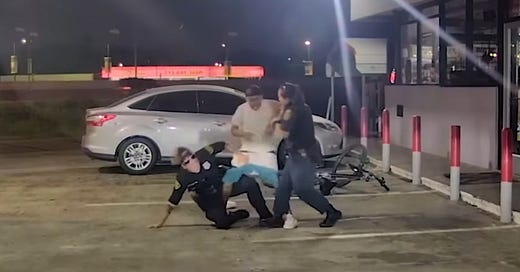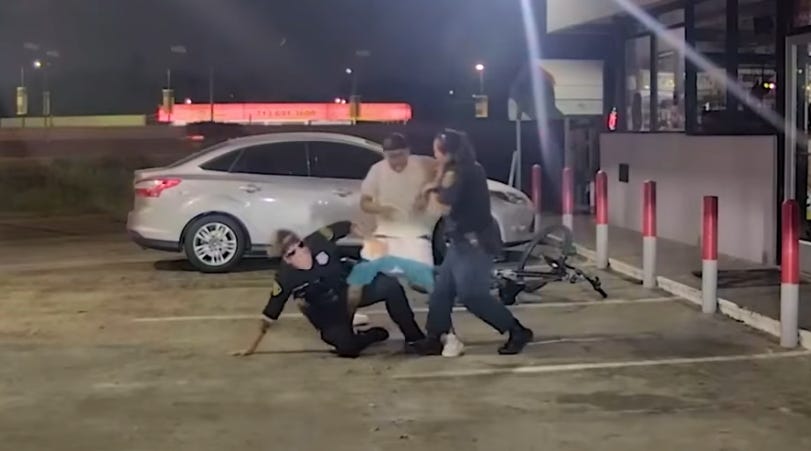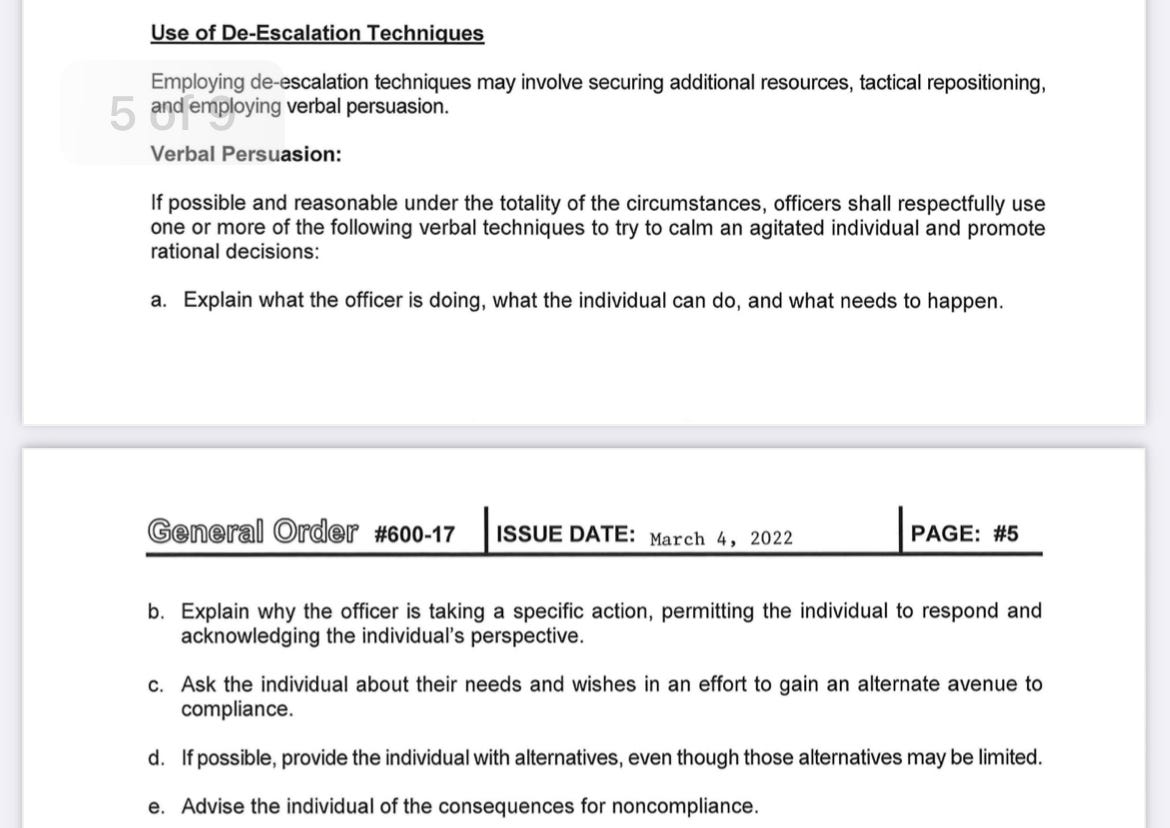There was a fatal Officer-Involved-Shooting (OIS) in Houston, TX that began when a suspect with a warrant (Edmundo Meza) resisted arrest and attempted to reach for a gun as he wrestled with two female police officers.
The use of deadly force in this case should not be controversial and the decision to cover this OIS came only after I watched a local Houston news report on the case that featured a retired Police Chief that served as a defacto “expert”.
I aim to respectfully (but aggressively) challenge the Chief’s assessment of this case.
What Happened
On August 7, 2024 two Houston, TX police officers were dispatched to a gas station where it had been reported that two males were “trespassing” at the business.
Officer Jillian McGowan and her partner arrived on scene and made contact with the men. Officers ran their information and found that one of the individuals (Edmundo Meza) had outstanding warrants for his arrest.
(body cam & surveillance video)
Arrest
Officer McGowan made the decision to place Mr. Meza under arrest for the warrants.
During the search of Mr. Meza (which was for some reason conducted before he was in handcuffs) - Officer McGowan discovered a handgun that was tucked inside his waistband. It was then that she tried to handcuff Mr. Meza and he resisted arrest.
Use of Force
Mr. Meza dragged both Officer McGowan and her partner to the ground.
Mr. Meza landed on his back and the other officer was positioned on his Mr. Meza’s left side - leaning over him. The officer was working to pin his right hand/arm to the ground with her left hand as well as control his left hand with her right hand - holding it behind his back.
Officer McGowan was controlling Mr. Meza’s legs, giving him verbal commands to comply, and pressing her firearm against his torso.
During this Mr. Meza did not comply and actively struggled with the officers by attempting to move his hands and break free from the officers’ grasp.
Officer McGowan gave Mr. Meza multiple warnings of force and stated, “Do not move!” and “I will shoot you!”.
After approximately 90 seconds Officer McGowan fired a single shot into Mr. Meza’s torso. He sustained a fatal injury.
Law & Policy
The Texas statute for Self-Defense reads (in part) as follows, “A person is justified in using deadly force against another…when and to the degree the actor reasonably believes the deadly force is immediately necessary: (A) to protect the actor against the other's use or attempted use of unlawful deadly force…”
The Houston Police Department policy on the use of deadly force reads as follows, “The use of deadly force shall be limited to those circumstances in which officers have an objectively reasonable belief that deadly force is necessary to protect themselves or others from the imminent threat of serious bodily injury or death.”
That language is pretty standard and you get the point. If Officer McGowan had a reasonable belief that she was in imminent danger of death or great bodily injury - then she would be justified in utilizing deadly force to prevent that.
Analysis
Was Officer McGowan’s use of deadly force reasonable?
Yes. Here’s why.
Mr. Meza resisted a lawful arrest.
When Officer McGowan yelled, “He has a gun!”. Mr. Meza responded, “No I don’t!”
This is further evidence of an attempt to conceal a firearm from officers.
Once he was on the ground he continued to resist arrest and struggled to break free.
Officer McGowan instructed him what to do and warned him of the consequences of noncompliance. Mr. Meza responded, “Shoot me!”.
And finally. If a suspect resists arrest and they are in possession of a gun - any reasonable officer would believe that if the suspect was successful - that they would utilize the gun in furtherance of their escape. No reasonable officer would grant a resisting, armed suspect like Mr. Meza the opportunity to and ability to murder them.
That warning of force (in combination with the officer’s gun pressed against his body) should have been an indication to Mr. Meza that the officers were serious and perceived a deadly threat - should he gain possession of the gun waiting in his waistband.
In a little under 90 seconds Officer McGowan ordered Mr. Meza to not “move” seventeen times and explained that the consequences for noncompliance were that she would “shoot” him - seven times.
There exists no police training or policy that would require police officers to continue to wrestle with a suspect like Mr. Meza until he was successful in his efforts to overpower the officers and then allow him the freedom to enjoy unrestricted access to the firearm.
*The use of deadly force was objectively reasonable.
The “expert”
A local Houston news station (KTRK) covered this story and had retired Texas Rangers Chief Tony Leal1 on to breakdown the case and provide his opinion. This is typical for a local news station to feature an expert to explain aspects of the case to the audience.
Chief Leal made a few statements that I strongly disagree with.
AD/ND
Chief Leal questioned whether or not the use of deadly force was intentional or an “accidental discharge”.
This seemed like an odd comment. There was nothing on the body cam video that would indicate that the use of deadly force was anything but intentional.
Also, the Chief used the term “accidental discharge” when it is likely that he meant “negligent discharge”. The difference between these terms is vast.
Accidental Discharge (AD)
An accidental discharge in the unintentional firing of a shot not due to improper gun handling and through no fault of the person handling the gun. In the vast majority of cases, an accidental discharge is due to mechanical failure or equipment malfunction.
Negligent Discharge (ND)
A negligent discharge is an unintentional firing of a shot due to a violation of the Four Universal Firearms Safety Rules, or other improper weapon handling. In the case of a negligent discharge, the fault lies entirely with the person handling the gun, and could have been prevented.
I am not trying to be overly critical of the Chief and anyone can misspeak.
There was simply just no evidence that Officer McGowan had an AD or an ND. If fact, after the shot was fired she threatened to shoot him again if he did not comply. Contrast that to the immediate reaction of shock and horror when former Officer Kim Potter had an ND and shot Daunte Wright.
To watch this body cam video and think that this was possibly an AD/ND - shows that the Chief just did not appreciate the obvious deadly threat facing the two officers who were fighting for their lives on the ground with an armed suspect.
Use of Force warnings
Chief Leal was “disturbed” by the use of force warnings issued by Officer McGowan prior to the OIS. “Those threats can escalate a situation” he opined.
This is perhaps the biggest issue that I have with the Chief’s comments.
Here’s why - the Houston Police Department has a policy on this exact issue and Officer McGowan followed it!
The use of deadly force policy requires officers to, “issue verbal warnings when possible prior to the use of deadly force”.
The “de-escalation” policy requires police officers to inform suspects of the “consequences for noncompliance”.
Officer McGowan followed the department policy.
This policy is not unique to Houston PD. The majority of large police departments have similar language in their de-escalation and UOF policies. This is considered “best practices”. To not know that - is an indication that the individual has been out of the policing/use of force policy world for quite some time.
If the Chief has an issue with this policy - I encourage debate on that topic.
My problem is that the Chief criticized the officer’s actions and even blamed her for “escalating” the situation - when, in reality, she was following department policy (as she is required to do). To not indicate that the officer was following the policy in this regard is extremely negligent.
It is almost as if the Chief did zero research on department policy and best practices before sitting for this interview and a predictable consequence of his carelessness was that a police officer was unjustly demonized for her use of deadly force - in front of thousands of local viewers.
Don’t reach…
The Chief stated, “I didn’t see where he reached for the weapon.”
The officers were trying to control his hands and it was obvious that he was actively resisting.
So, in your ‘expert’ opinion, what was Mr. Meza reaching for?
Final Thoughts
After an OIS police officers are not allowed to make any public statements to defend themselves. And, that is often where I come in.
Officers in these situations have to endure dishonest public criticism from grifting attorneys and inconsolable family members - but, negligent criticism from a former police chief/expert is typically not on a cop’s radar - and it shouldn’t be.
I am operating under the notion that Chief Leal is an honorable man who just made a mistake in this instance. That’s why I am asking Chief Leal to apologize to Officer McGowan and issue a public retraction of his comments - at least about the warning of force issue - as she was clearly following the de-escalation policy of the Houston Police Department.
If Chief Leal reads this article and believes that my criticism was too harsh - it wasn’t as harsh as accusing an officer of “escalating” a deadly use of force encounter - a serious accusation that could lead to an officer being imprisoned and riots in the streets.
He retired in 2011.









Another excellent article and very good descriptive analysis. Great job on being fair to the retired Chief Leal but providing commentary devoid of reference to the actual policy and guidance given to the officer, and the fact that the suspect was possibly winning against the officers when they did was necessary and appropriate. Planting seeds of doubt because a retired commentator wants to be on the news in a case like this was very bad and could have been much worse. Keep up the great work DC!
I agree with you wholeheartedly up to and including the requests for apologies to the officers. I don't know how much street patrol action Texas Rangers get but.... Seems researching the departments policies would have led the retired chief to a different conclusion.